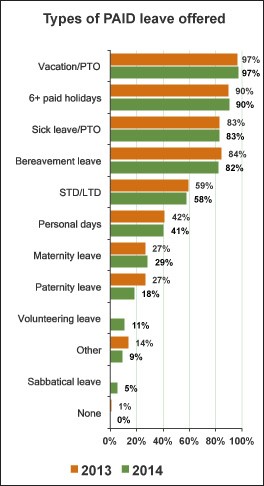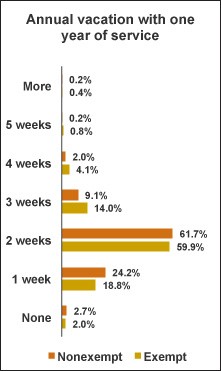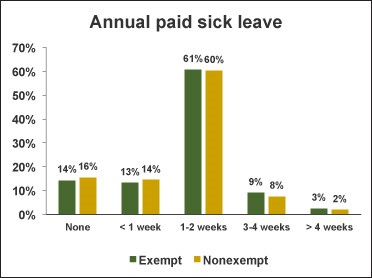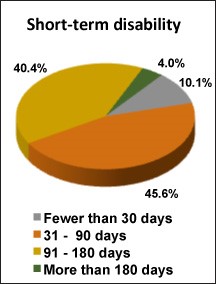Thanks to all 3,158 individuals who participated in the survey! Here are the detailed responses:
 |
Highlights of the 2014 Employee Leave Survey:
- 97% offer some type of vacation pay.
- 80% allow employees to take sick time for sick relatives.
- 30% allow some form of leave sharing.
- As for top challengers regarding employee leave, scheduling workloads around employee leave topped the list at 49.8% followed by recordkeeping and/or tracking leave at 37%, abuse of leave at 36.5%, and FMLA intermittent leave at 33.5%.
Thanks to all 3,158 individuals who participated in the survey! Here are the detailed responses:
Leave types
Much like last year (96%), this year’s survey shows that 98.9% of participants offer some form of time off to employees. Paid vacation time, separately or as paid time off (PTO), is available to over 97% of those responding to our survey, while paid sick leave is an option for 82.7%, and paid personal days are available for 44.7%. Vacation and sick leave are computed separately by 64.1% and as part of a PTO Plan by 35.6%.
Paid bereavement leave is offered by 82.1% and 90.1% offer 6 or more paid holidays per year. Extended medical leave is offered by 58.2% and maternity/paternity leave is offered separate from other sick leave by 28.6%.

Are class action lawyers peering at your comp practices? It’s likely, but you can keep them at bay by finding and eliminating any wage and hour violations yourself. Our editors recommend BLR’s easy-to-use FLSA Wage & Hour Self-Audit Guide. Click here for details.
Vacation
The first year of employment provides 2 weeks of vacation time to both exempt and nonexempt employees for the majority of our survey respondents, at 59.9% and 61.7%. One week is offered to exempt employees for 18.8% (16.9% in 2013 and 20% in 2012) and to nonexempt employees for 24.2% (22.2% in 2013 and 23% in 2012). Three weeks or more is provided to exempt employees for 14% compared to 19.5% last year, and 9.1% offer 3 weeks or more to nonexempt employees, compared to 9.9% in 2013.
Five years of employment provides exempt employees with 3 weeks of vacation for 55.6% (52% in 2013) of survey participants and 56.1% (53.6% in 2013) provide nonexempt employees with 3 weeks. Four weeks or more is provided to exempt employees for 15.2% (20% in 2013) and to nonexempt employees for 10% (10% in 2013). No vacation is provided to exempt employees for 1.3% of our respondents and 2% provide zero vacation to nonexempt employees.
Ten years of employment brings exempt employees 4 weeks of vacation for 41.9% and brings nonexempt employees the same for 39.3%. Five weeks or more is provided to exempt employees for 7.8% (10.2% in 2013) and to nonexempt employees for 5.6% (7.7% in 2013).
Fifteen years of service grants exempt employees 4 weeks of vacation for 53% and brings nonexempt employees the same for 52.2%. Five weeks or more is provided to exempt employees for 14.7% and to nonexempt employees for 12.6%.
Exempt employees with more than 15 years of service receive 3 to 4 weeks of vacation for 56.6% who answered this question and 57.5% provide the same for nonexempt employees. No vacation, however, is provided to exempt employees for 3.2% of our respondents and 3.7% provide zero vacation to nonexempt employees.

How Do You Handle Sick Time?
Less than one week is the amount of sick leave provided to exempt employees for 13.2% of our respondents who offer this benefit and nonexempt employees receive the same for 14.5%. Exempt employees receive 1 to 2 weeks per year for 60.8% of survey participants and nonexempt employees receive the same for 60.4%. Exempt employees have 3 to 4 weeks per year for 9.1% and nonexempt employees get that amount for 7.6%. More than 4 weeks per year is the norm for exempt employees at 2.5% and for nonexempt employees at 2%.
Employees may use sick time to care for a dependent for 79.7% (80.3% in 2013) who answered this question and, of this group, 98.2% allow its use to care for a sick child, while 94% allow use of employee sick time to care for a spouse. It starts to drop when employees need time off to care for a parent (82.4%) and continues to decline when employees need to care for a sibling or grandparent (45.1% and 45.9%, respectively).

What Do You Offer for Disability Leave?
Paid short-term disability (STD) leave is provided by 49.4%, with leave of fewer than 30 days the rule for 10.1% of survey participants who responded to this question. STD leave of 31 to 90 days is available to 45.6% and 91 to 180 days is allowed for 40.4%. When it comes to how much of STD leave is paid, 64.9% (59.6% in 2013) cover 51% to 75% of employees’ base pay and 16.6% (20.4% in 2013) cover 76% to 100%.
Paid long-term disability (LTD) leave is a benefit for 47.8%, with leave of more than a year available for 55.6% (51.3% in 2013) of survey participants who answered this question. LTD of 6 months to a year is an option for 16.3% (17.8% in 2013) and 4 to 6 months of paid LTD is available for 13%, while 2 to 4 months is a benefit for 10.3%. LTD pay covers 51% to 75% of base pay for 81% (75.1% in 2013) and 26% to 50% of base pay for 10.3% (11.9% in 2013).

All you need to avoid exempt/nonexempt classification and overtime errors, now in BLR’s award-winning FLSA Wage & Hour Self-Audit Guide. Find out more.
Paid Time Off (PTO)
The first year of employment provides 2 weeks of PTO to exempt employees for 20.8% (19.2% and 31% in 2013 and 2012, respectively) of those who offer this benefit, and nonexempt employees receive the same for 21.2% (20.6% and 32% in 2013 and 2012, respectively). One week is offered to exempt employees for 12.9% (9.6% in 2013) and to nonexempt employees for 14.9% (11.9% in 2012). Three weeks or more is offered by 27.8% (30.8% in 2013) to exempt employees and 24.5% (25.9% in 2013) offer 3 weeks or more to nonexempt employees.
Five years of employment provides exempt employees with 3 weeks of PTO for 18.2% of survey participants and 19.1% provide nonexempt employees with 3 weeks. Four weeks or more is provided to exempt employees for 16.4% and to nonexempt employees for 15.1%. Zero PTO is provided to exempt employees for 37.9% of our respondents and 39.2% provide no PTO to nonexempt employees.
Ten years of employment brings 4 weeks of PTO to exempt employees for 18.1% and the same to nonexempt employees for 18.3% of those who responded to this question in our survey. Five weeks or more is provided to exempt employees for 24% and to nonexempt employees for 21.5%.
Fifteen years of service gets exempt employees 4 weeks of PTO for 16.1% and brings nonexempt employees the same for 15.9%. Five weeks or more is provided to exempt employees for 15.1% and to nonexempt employees for 14.7%.
Exempt employees with more than 15 years of service receive 3 to 4 weeks of vacation for 18.4% who answered this question and 19% provide the same for nonexempt employees. Employees who are exempt receive 5 to 6 weeks of PTO, however, for 24.2% and nonexempt employees receive the same for 22.5%.

In tomorrow’s Advisor, more survey results, including various types of leave employers offer, plus we introduce BLR’s authoritative wage and hour self-audit guide.
